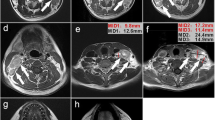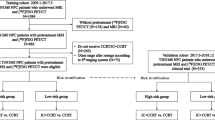Abstract
Objectives
This study aimed to assess the prognostic value of quantitative cervical nodal necrosis (CNN) burden in N staging risk stratification in patients with nasopharyngeal carcinoma.
Methods
Univariate and multivariate Cox regression models evaluated the association between lymph node variables based on MRI images and survival. Revisions for the N classification system were proposed and compared to the 8th edition AJCC staging system using Harrell’s concordance index (C-index). The survival outcomes of induction chemotherapy plus concurrent chemoradiotherapy (CCRT) and CCRT alone in patients with multiple CNNs were compared.
Results
In 1319 patients enrolled, CNN was not an independent prognostic factor for the main survival outcomes, but multiple CNNs (three or more necrotic nodes) were independent prognostic factors for distant metastasis-free survival (DMFS) (adjusted hazard ratio [HR], 2.05; p = 0.020) and progression-free survival (PFS) (HR, 1.78; p = 0.004), surpassing other nodal variables. On upgrading patients with multiple CNNs to revised N3 disease, the proposed N staging widened the differences in DMFS and PFS between N2 and N3 disease. The overall survival of patients with multiple CNNs who received CCRT plus induction chemotherapy was improved compared to that of those who received CCRT alone (76.1% vs. 55.7%; adjusted p = 0.030).
Conclusions
Upgrading patients with multiple CNNs to stage N3 may improve prognostication of the current AJCC staging system. Multiple CNNs might be a potential marker for stratifying patients who would benefit from induction chemotherapy.
Key Points
• Quantitatively assessed the prognostic value of CNN burden in patients with NPC.
• Upgrading patients with multiple CNNs to stage N3 may improve prognostication.
• Multiple CNNs may be used as a stratification marker for induction chemotherapy.





Similar content being viewed by others
Abbreviations
- AJCC:
-
American Joint Committee on Cancer
- CCRT:
-
Concurrent chemoradiotherapy
- CNN:
-
Cervical nodal necrosis
- DMFS:
-
Distant metastasis-free survival
- EBV:
-
Epstein-Barr virus
- ENS:
-
Extranodal neoplastic spread
- LN:
-
Lymph node
- NPC:
-
Nasopharyngeal carcinoma
- PFS:
-
Progression-free survival
- RFS:
-
Recurrence-free survival
References
Edge SBBR, Jessup JM et al (2017) American Joint Committee on Cancer Cancer staging manual
Pan JJ, Ng WT, Zong JF et al (2016) Proposal for the 8th edition of the AJCC/UICC staging system for nasopharyngeal cancer in the era of intensity-modulated radiotherapy. Cancer 122:546–558
Mao YP, Liang SB, Liu LZ et al (2008) The N staging system in nasopharyngeal carcinoma with radiation therapy oncology group guidelines for lymph node levels based on magnetic resonance imaging. Clin Cancer Res 14:7497–7503
Liu Y, Chen S, Dong A et al (2020) Nodal grouping in nasopharyngeal carcinoma: prognostic significance, N classification, and a marker for the identification of candidates for induction chemotherapy. Eur Radiol 30:2115–2124
Ma H, Qiu Y, Li H et al (2021) Prognostic value of nodal matting on MRI in nasopharyngeal carcinoma patients. J Magn Reson Imaging JMRI 53:152–164
Yin X, Lv L, Pan XB (2020) Prognosis of extracapsular spread of cervical lymph node metastases in nasopharyngeal carcinoma. Front Oncol 10:1–8
Ma H, Liang S, Cui C et al (2020) Prognostic significance of quantitative metastatic lymph node burden on magnetic resonance imaging in nasopharyngeal carcinoma: a retrospective study of 1224 patients from two centers. Radiother Oncol 151:40–46
Lan M, Huang Y, Chen C-Y et al (2015) Prognostic value of cervical nodal necrosis in nasopharyngeal carcinoma: analysis of 1800 patients with positive cervical nodal metastasis at MR imaging. Radiology 276:536–544
Chong VF, Fan YF, Khoo JB (1996) MRI features of cervical nodal necrosis in metastatic disease. Clin Radiol 51:103–109
King AD, Tse GMK, Ahuja AT et al (2004) Necrosis in metastatic neck nodes: diagnostic accuracy of CT, MR imaging, and US. Radiology 230:720–726
Amin MBES, Greene FL et al (2016) AJCC cancer staging manual, 8th edn. Springer, New York
Tang LL, Chen YP, Mao YP et al (2017) Validation of the 8th edition of the UICC/AJCC staging system for nasopharyngeal carcinoma from endemic areas in the intensity-modulated radiotherapy era. J Natl Compr Canc Netw 15:913–919
Liang SB, Chen LS, Yang XL et al (2021) Influence of tumor necrosis on treatment sensitivity and long-term survival in nasopharyngeal carcinoma. Radiother Oncol 155:219–225
Tang LQ, Li CF, Li J et al (2016) Establishment and validation of prognostic nomograms for endemic nasopharyngeal carcinoma. J Natl Cancer Inst 108
Liu K, Lin S, Ke L et al (2020) Prognostic value and the potential role of treatment options for cervical lymph node necrosis in nasopharyngeal carcinoma. Oral Oncol 109:104864–104864
Liu LZ, Zhang GY, Xie CM, Liu XW, Cui CY, Li L (2006) Magnetic resonance imaging of retropharyngeal lymph node metastasis in nasopharyngeal carcinoma: patterns of spread. Int J Radiat Oncol Biol Phys 66:721–730
Zhang LL, Li JX, Zhou GQ et al (2017) Influence of cervical node necrosis of different grades on the prognosis of nasopharyngeal carcinoma patients treated with intensity-modulated radiotherapy. J Cancer 8:959–966
Xie C, Li H, Yan Y et al (2020) A nomogram for predicting distant metastasis using nodal-related features among patients with nasopharyngeal carcinoma. Front Oncol 10:1–9
Zhang LL, Zhou GQ, Li YY et al (2017) Combined prognostic value of pretreatment anemia and cervical node necrosis in patients with nasopharyngeal carcinoma receiving intensity-modulated radiotherapy: a large-scale retrospective study. Cancer Med 6:2822–2831
Huang L, Zhang Y, Liu Y et al (2019) Prognostic value of retropharyngeal lymph node metastasis laterality in nasopharyngeal carcinoma and a proposed modification to the UICC/AJCC N staging system. Radiother Oncol 140:90–97
Li WF, Sun Y, Mao YP et al (2013) Proposed lymph node staging system using the international consensus guidelines for lymph node levels is predictive for nasopharyngeal carcinoma patients from endemic areas treated with intensity modulated radiation therapy. Int J Radiat Oncol Biol Phys 86:249–256
Wan Y, Tian L, Zhang G et al (2019) The value of detailed MR imaging report of primary tumor and lymph nodes on prognostic nomograms for nasopharyngeal carcinoma after intensity-modulated radiotherapy. Radiother Oncol 131:35–44
Don DM, Anzai Y, Lufkin RB, Fu YS, Calcaterra TC (1995) Evaluation of cervical lymph node metastases in squamous cell carcinoma of the head and neck. Laryngoscope 105:669–674
Som PM (1987) Lymph nodes of the neck. Radiology 165:593–600
Zhou X, Ou X, Yang Y et al (2018) Quantitative metastatic lymph node regions on magnetic resonance imaging are superior to AJCC N classification for the prognosis of nasopharyngeal carcinoma. J Oncol 2018
Yang X-L, Wang Y, Liang S-B et al (2018) Comparison of the seventh and eighth editions of the UICC/AJCC staging system for nasopharyngeal carcinoma: analysis of 1317 patients treated with intensity-modulated radiotherapy at two centers. BMC Cancer 18
Zhang Y, Chen L, Hu GQ et al (2019) Gemcitabine and cisplatin induction chemotherapy in nasopharyngeal carcinoma. N Engl J Med 381:1124–1135
Du XJ, Tang LL, Chen L et al (2015) Neoadjuvant chemotherapy in locally advanced nasopharyngeal carcinoma: defining high-risk patients who may benefit before concurrent chemotherapy combined with intensity-modulated radiotherapy. Sci Rep 5:16664
Xu C, Sun R, Tang LL et al (2018) Role of sequential chemoradiotherapy in stage II and low-risk stage III-IV nasopharyngeal carcinoma in the era of intensity-modulated radiotherapy: a propensity score-matched analysis. Oral Oncol 78:37–45
Sun Y, Li WF, Chen NY et al (2016) Induction chemotherapy plus concurrent chemoradiotherapy versus concurrent chemoradiotherapy alone in locoregionally advanced nasopharyngeal carcinoma: a phase 3, multicentre, randomised controlled trial. Lancet Oncol 17:1509–1520
He M, Wu H, Jiang Q et al (2019) Hypoxia-inducible factor-2α directly promotes BCRP expression and mediates the resistance of ovarian cancer stem cells to adriamycin. Mol Oncol 13:403–421
Dong L, You S, Zhang Q et al (2019) Arylsulfonamide 64B inhibits hypoxia/HIF-induced expression of c-Met and CXCR4 and reduces primary tumor growth and metastasis of uveal melanoma. Clin Cancer Res 25:2206–2218
Lambin P, Rios-Velazquez E, Leijenaar R et al (2012) Radiomics: extracting more information from medical images using advanced feature analysis. Eur J Cancer 48:441–446
Aerts HJ, Velazquez ER, Leijenaar RT et al (2014) Decoding tumour phenotype by noninvasive imaging using a quantitative radiomics approach. Nat Commun 5:4006
Acknowledgements
We would like to thank Editage (www.editage.com) for their writing support.
Funding
This work was supported by the Key-Area Research and Development of Guangdong Province (2020B1111190001); Science and Technology Planning Project of Guangzhou City, China [Grant No. 201907010043].
Author information
Authors and Affiliations
Corresponding authors
Ethics declarations
Guarantor
The scientific guarantor of this publication is Lizhi Liu.
Conflict of interest
The authors of this manuscript declare no relationships with any companies, whose products or services may be related to the subject matter of the article.
Statistics and biometry
No complex statistical methods were necessary for this paper.
Informed consent
Written informed consent was obtained from all subjects (patients) in this study.
Ethical approval
Institutional Review Board approval was obtained.
Study subjects or cohorts overlap
Some study subjects or cohorts have been previously reported in Radiotherapy and Oncology and European Radiology.
Methodology
• retrospective
• diagnostic or prognostic study
• performed at one institution
Additional information
Publisher’s note
Springer Nature remains neutral with regard to jurisdictional claims in published maps and institutional affiliations.
Rights and permissions
About this article
Cite this article
Li, J., Zhao, Q., Zhang, Y. et al. Prognostic value of quantitative cervical nodal necrosis burden on MRI in nasopharyngeal carcinoma and its role as a stratification marker for induction chemotherapy. Eur Radiol 32, 7710–7721 (2022). https://doi.org/10.1007/s00330-022-08785-5
Received:
Revised:
Accepted:
Published:
Issue Date:
DOI: https://doi.org/10.1007/s00330-022-08785-5




